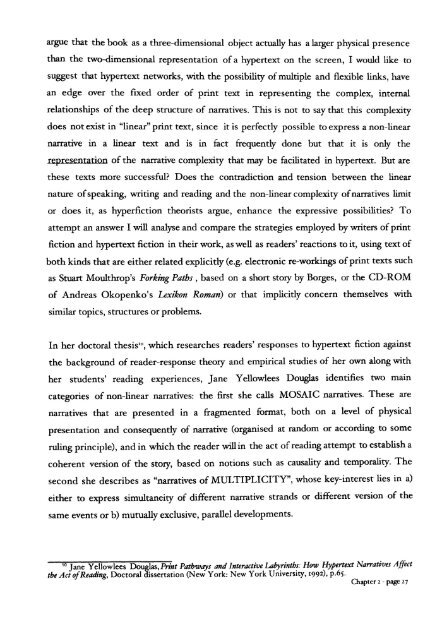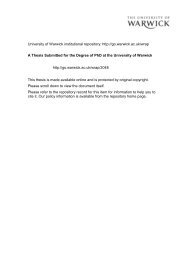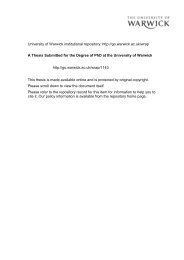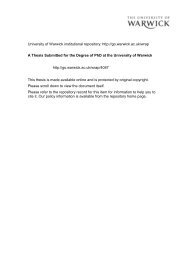From Page to Screen - WRAP: Warwick Research Archive Portal ...
From Page to Screen - WRAP: Warwick Research Archive Portal ...
From Page to Screen - WRAP: Warwick Research Archive Portal ...
Create successful ePaper yourself
Turn your PDF publications into a flip-book with our unique Google optimized e-Paper software.
argue that the book as a three-dimensional object actually has a larger physical presence<br />
than the two-dimensional representation of a hypertext on the screen, I would like <strong>to</strong><br />
suggest that hypertext networks, with the possibility ofmultiple and flexible links, have<br />
an edge over the fixed order of print text in representing the complex, internal<br />
relationships of the deep structure of narratives. This is not <strong>to</strong> say that this complexity<br />
does not exist in "linear" print text, since it is perfectly possible <strong>to</strong> express a non-linear<br />
narrative in a linear text and is in fact frequently done but that it is only the<br />
representation ofthe narrative complexity that may be facilitated in hypertext. But are<br />
these texts more successful? Does the contradiction and tension between the linear<br />
nature ofspeaking, writing and reading and the non-linear complexity ofnarratives limit<br />
or does it, as hyperfiction theorists argue, enhance the expressive possibilities? To<br />
attempt an answer I will analyse and compare the strategies employed by writers ofprint<br />
fiction and hypertext fiction in their work, as well as readers' reactions <strong>to</strong> it, using text of<br />
both kinds that are either related explicitly (e.g. electronic re-workings ofprint texts such<br />
as Stuart Moulthrop's Forking Paths, based on a short s<strong>to</strong>ry by Borges, or the CD-ROM<br />
of Andreas Okopenko's Lexikon Roman) or that implicitly concern themselves with<br />
similar <strong>to</strong>pics, structures or problems.<br />
In her doc<strong>to</strong>ral thesis"; which researches readers' responses <strong>to</strong> hypertext fiction against<br />
the background of reader-response theory and empirical studies of her own along with<br />
her students' reading experiences, Jane Yellowlees Douglas identifies two main<br />
categories of non-linear narratives: the first she calls MOSAIC narratives. These are<br />
narratives that are presented in a fragmented format, both on a level of physical<br />
presentation and consequently of narrative (organised at random or according <strong>to</strong> some<br />
ruling principle), and in which the reader willin the act ofreading attempt <strong>to</strong> establish a<br />
coherent version of the s<strong>to</strong>ry, based on notions such as causality and temporality. The<br />
second she describes as "narratives of MULTIPLICITY", whose key-interest lies in a)<br />
either <strong>to</strong> express simultaneity of different narrative strands or different version of the<br />
same events or b) mutually exclusive, parallel developments.<br />
10 Jane Yellowlees Douglas,Print Pathways and Interactive Labyrintbs: How Hypertext Narratives Affect<br />
theAc<strong>to</strong>fReading, Doc<strong>to</strong>ral dissertation (New York: New York University, 1992) , p.65· Chapter 2 - page 21





